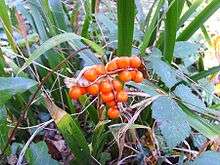Iris foetidissima
Iris foetidissima, the stinking iris,[1] gladdon, Gladwin iris, roast-beef plant, or stinking gladwin, is a species of iris found in open woodland, hedgebanks and sea-cliffs.
| Iris foetidissima | |
|---|---|
| Stinking iris flower | |
| Scientific classification | |
| Kingdom: | Plantae |
| Clade: | Tracheophytes |
| Clade: | Angiosperms |
| Clade: | Monocots |
| Order: | Asparagales |
| Family: | Iridaceae |
| Genus: | Iris |
| Subgenus: | Iris subg. Limniris |
| Section: | Iris sect. Limniris |
| Series: | Iris ser. Foetidissimae |
| Species: | I. foetidissima |
| Binomial name | |
| Iris foetidissima | |
Its natural range is Western Europe, including England south of Durham and also Ireland, and from France south and east to N. Africa, Italy and Greece.[2]

It is one of two iris species native to Britain, the other being the yellow iris (Iris pseudacorus).
It has tufts of dark green leaves.[1] Its flowers are usually of a dull, leaden-blue colour, or dull buff-yellow tinged with blue; the seed capsules, which remain attached to the plant throughout the winter, are 5–8 cm long; and the seeds are scarlet.
It is known as "stinking" because some people find the smell of its leaves unpleasant when crushed or bruised,[1] an odour that has been described as "beefy".
This plant is cultivated in gardens in the temperate zones. Both the species[3] and its cultivar 'Variegata'[4] have gained the Royal Horticultural Society's Award of Garden Merit.[5]
Notes and references
- Richard Fitter, Alastair Fitter and Marjorie Blamey Wild Flowers of Britain and Northern Europe (1996), p. 284, at Google Books
- Plants For A Future: Iris foetidissima
- "RHS Plant Selector - Iris foetidissima". Royal Horticultural Society. Retrieved 2013-05-20.
- "RHS Plant Selector - Iris foetidissima 'Variegata'". Royal Horticultural Society. Retrieved 2013-05-20.
- "AGM Plants - Ornamental" (PDF). Royal Horticultural Society. July 2017. p. 53. Retrieved 13 March 2018.

| Wikimedia Commons has media related to Iris foetidissima. |